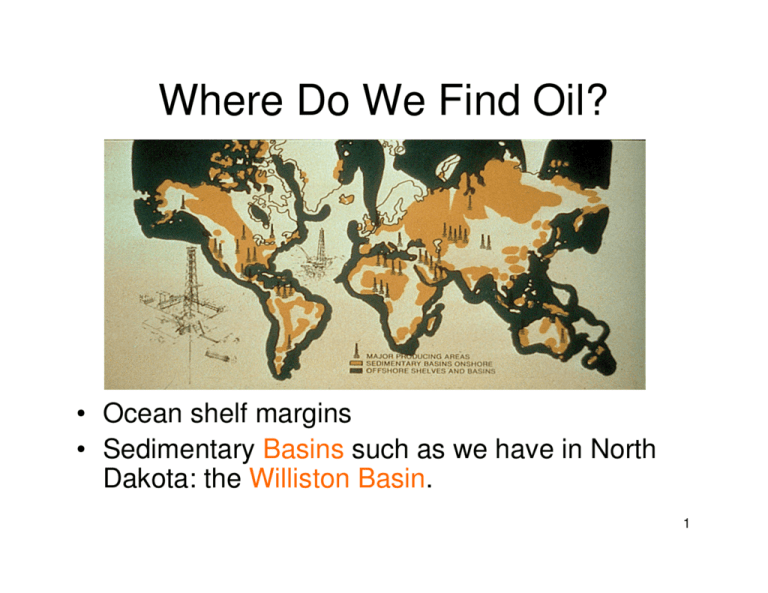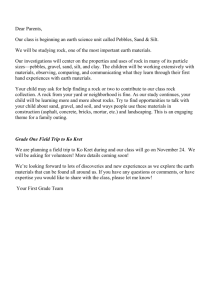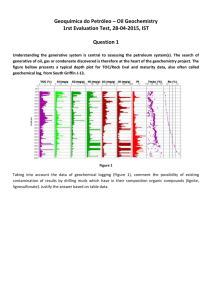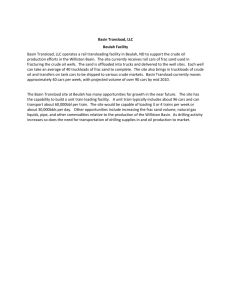Where Do We Find Oil? - North Dakota Petroleum Council
advertisement

Where Do We Find Oil? • Ocean shelf margins • Sedimentary Basins such as we have in North Dakota: the Williston Basin. 1 What is a Basin? • A basin is a depression on the earths surface caused by a down-warp in the crust. • Think of a basin as a mixing bowl filled with water and into which ingredients (sediments) are added. 2 • Exercise: • 1. Supply students with a map of the Williston Basin showing states and provinces, a 24 oz. clear plastic or glass bowl, 6 color packet sets of art sand (available at Hobby Lobby), a measuring cup, and a plastic scoop. • 2. Determine Geographic North on the Williston Basin map. • 3. Fill bowl with approximately 16 oz of water and place bowl in the center of the Williston Basin map. • 4. Use plastic scoop to add 2-3 oz of art sand to the water filled bowl. Use a different color of art sand to represent the deposition of each formation to be discussed. 3 • 5. In this demonstration the first three scoops of art sand will be added from a north direction on the Williston Basin map, representing deposition of the Lower Bakken Shale, Middle Bakken Member, and the Upper Bakken Shale. • 6. Water levels can be raised or lowered to represent sea level fluctuations. • 7. The final three scoops of art sand should be introduced to the bowl from a westerly direction on the Williston Basin map, representing deposition of the Lodgepole and Lower Madison Formations through the Montana Trough. •8. Rotate or agitate the sand filled bowl to even out the sand layers. Observe the resulting structural changes to each formation 4 Time 1 – Lower Bakken Shale Northeast Depocenter – White Earth, ND 5 Time 2 – Middle Bakken Siltstone Northeast Depocenter – White Earth, ND 6 Time 3 – Upper Bakken Shale Northeast Depocenter – White Earth, ND 7 Time 4 – Lodgepole, Mission Canyon & Ratcliffe West Depocenter – Watford City, ND 8 • • • • • • • 2. 3. 4. Exercise: 1. Supply student with the following information: a. Williston basin is approximately 400 miles in diameter. b. Williston basin is approximately 3 miles deep. c. Williston basin volume can be approximated as 1/6(Pi)(depth)(3r2+depth2). d. Mount Everest (tallest mountain in the world) contains approximately 36 cubic miles of rock. e. The average interior sedimentary basin contains 100,000 barrels of recoverable oil per cubic mile. Calculate how many cubic miles of rock the Williston basin contains. (188,510) Calculate how many mount Everest’s were eroded away to fill the Williston basin. (5,236) Calculate how many barrels of recoverable oil the Williston Basin originally contained. (18.9 billion) 9 • Exercise: • 1. Supply student with a pint or quart jar with a seal tight lid and a mixture of fine gravel, sand, silt and clay. River sediment works well. • 2. Fill jar half full of sediment mixture and remainder with water. • 3. Shake jar vigorously until all sediment is suspended in the water. • 4. Set jar on flat surface and observe. (sedimentation) • 5. Which grains settle out first? (gravel) Which grains settle out last? (fine clay) • 6. How does Stokes’ Law apply to this exercise? (determines the order in which the particles settle out) • 7. How would this sediment react if it were carried in suspension by a swift flowing river and then deposited onto a gently sloping lake bed? (gravel closest to shore, then sand, and finally fine clay far from shore) 10 Basin • The sequence of materials (sediments) in the basin eventually are turned into sedimentary rock • Each Unit in the sequence has a unique depositional history and specific physical properties of the rock that comprises it. • The sequence of rock is referred to as a stratigraphic column 11 • Exercise: • 1. Refer students to the North Dakota Stratigraphic Column. • 2. Find the following formations on the stratigraphic column and determine their Age, Erathem and System. • a. Source Rock – Bakken Shale • b. Reservoir Rock – Lodgepole Mounds • c. Seal or Cap Rock – Lodgepole Lime/Mudstone • 3. Can you identify other potential source, reservoir, and cap rocks? – Icebox, Tyler Shales, Black Island, Mission Canyon, Spearfish, Roughlock, Prarie Evaporite, Charles Salt, Pine Salt and Saude Siltstone 12 Lodgepole - Mississippian • This was a nice time in North Dakota, but a little wet. • Caribbean climate: the area was inundated by a shallow sea. • Patch and fringing reefs as well as Walsortian mounds developed along the basin margins. 13 Pinnacle Reef - Walsortian Mound • Pinnacle reefs are nearly cylindrical with vertical sides. • Walsortian mounds are similar but less regular in shape, and larger in area. • During times of relative sealevel rise, to avoid ‘drowning’, they grow upward more than outward. • Reef and mound growth initiated on organic rich sea bottom sediments like the Bakken. 14 Pinnacle Reef - Walsortian Mound • In the Williston Basin a sea level rise drowned the mounds and buried them in and under hundreds of feet of mudstone. Mudstone Mound 15 Bakken Source OIL There are Only Four Factors Controlling Oil Production!! 16 Oil Production • Source • Reservoir • Trap • Economics -There is more $100.00 bbl oil than there is $10.00 bbl oil. 17 • Petroleum/Oil: complex mixture of naturally occurring organic compounds. Source • Organic rich sediments are buried in a basin. • Through time, under pressure and temperature associated with deep burial, organics undergo physical and chemical changes, eventually forming oil. 18 Source • A good source rock is a black organic rich shale (mud) such as the Bakken. • Once the generation of oil has begun, it normally begins to move (migrate) through the rock column. 19 • Exercise: • 1. Supply each student with a glass jar, 1 cup sand, 1/3 cup cooking oil, marbles and water. • 2. Pour sand and cooking oil into glass jar and mix. • 3. Add 2-3 inches of marbles on top of sand/oil mixture. • 4. Add water to top of marbles in jar. • 5. Set aside and observe migration of oil from sand (source rock) into marbles (reservoir rock). 20 Reservoir • A reservoir rock is a rock that is capable of storing a fluid or gas. • There are 2 requirements for a reservoir: 1. Porosity 2. Permeability CONNATE WATER IN PORE SPACE • A rock with pores is referred to as porous. • It has tiny holes within which fluid (oil, water, gas) may be stored. OIL IN PORE SPACE 21 Reservoir • A reservoir rock is also permeable. That means its pores are connected. • If hydrocarbons are in the pores of a rock, they must be able to move out of them. LOW PERMEABILITY PORE CHANNEL • Sandstones and carbonates (limestones) are good reservoir rock. • A sponge is a good visual of a reservoir rock. HIGH PERMEABILITY PORE CHANNEL 22 • Exercise: • 1. Supply each student with 2 identical glass jars, marbles and a measuring cup. • 2. Place marbles in one jar and mark both jars at the top of the marbles. • 3. Using the measuring cup fill the jar without marbles with water up to the mark and record the volume (this is Total Bulk Volume). • 4. Using the measuring cup fill the jar that contains the marbles with water up to the mark at the top of the marbles. Again, record this amount (this is Volume of Pore Space). • 5. Determine porosity. • 6. Porosity = Volume of Pore Space / Total Bulk Volume 23 • • • • Exercise: 1. Supply each student with 5-10 drinking straws. 2. Have students hold straws in a bundle. 3. Discuss with students that porosity of the straw bundle is the same from every angle. • 4. Have students hold straws vertical and pour water through them to show high permeability with high porosity (pore space is connected). • 5. Have students hold straws horizontal and pour water over them to show low permeability with the same high porosity (pore space is not connected). 24 A Walsortian mound is a good reservoir! A continuous resource like the Bakken is a very poor reservoir! 25 Trap • Under reservoir conditions oil is mobile; it therefore needs to be trapped, and accumulate to be produced. • A rock that does not have permeability (impermeable) serves as a trapping material. • Shale, salts and anhydrites are good trap rocks. 26 TRAPS There are 2 primary trap types: structural and stratigraphic. There are subtypes (faults and pinch-outs) and combinations of structure and stratigraphy. A reef or mound is a combination trap 27 • Exercise: • 1. Supply students with a flexible writing tablet with multicolored sections (if a tablet is not available, use colored paper – at least 10 sheets of 4 different colors). • 2. Hold the paper or tablet at the end of the long axis. Apply pressure inward from both ends and: • a. Form an anticline • b. Form a syncline • c. Form a combination anticline-syncline • 3. Pull one layer of paper out remove half the sheets and fold half of the sheets in half. Put the folded sheets back in the stack and bend the stack to form structural dip with the short layer sloping upward. • 4. Observe how the cap rock and source rock come together to form a seal on the end of the reservoir rock. 28 • Exercise: • 5. Supply students with photocopies of USGS Fault exercise. • 6. Identify each layer using different colored highlighters to represent limestone, dolomite, sandstone and shale. • 7. Follow instructions to create a normal fault, thrust fault, and slip fault. • 8. Observe how the shale cap rock can now create a seal on the reservoir rock. 29 Summary 30








